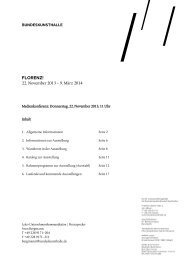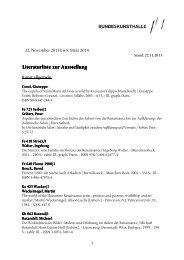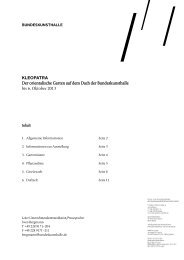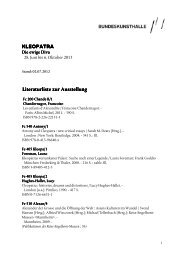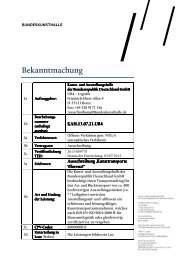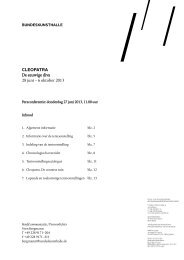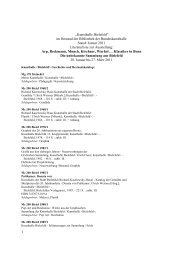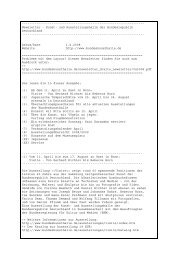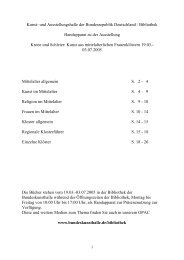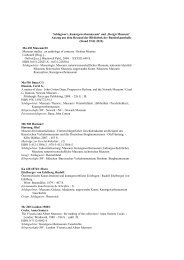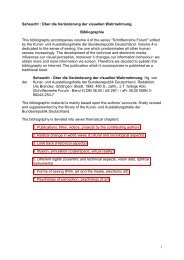Peoples through space and time Archaeology in Germany 09.05 ...
Peoples through space and time Archaeology in Germany 09.05 ...
Peoples through space and time Archaeology in Germany 09.05 ...
You also want an ePaper? Increase the reach of your titles
YUMPU automatically turns print PDFs into web optimized ePapers that Google loves.
Gifts to the Gods<br />
Valuable tools, weapons, jewelry <strong>and</strong> also vessels made of gold, bronze <strong>and</strong> clay are found <strong>time</strong> <strong>and</strong><br />
aga<strong>in</strong> <strong>in</strong> specific comb<strong>in</strong>ations at special sites. These sites <strong>in</strong>clude rivers, lakes, moors, mounta<strong>in</strong> tops,<br />
passes <strong>and</strong> former holy sites, now <strong>in</strong>conspicuous to the modern eye. The valuable goods were obviously<br />
buried with the <strong>in</strong>tention never to be brought to light aga<strong>in</strong>.<br />
Because of its regularity, it is given cult significance <strong>and</strong> <strong>in</strong>terpreted as a universal religious act. The<br />
so-called hoard f<strong>in</strong>ds entailed gifts to the gods, furnish<strong>in</strong>gs for the after-life or cult <strong>in</strong>struments that were<br />
to be divested of their sacred or profane use forever.<br />
Warrior <strong>and</strong> Charioteers<br />
The exam<strong>in</strong>ation of entire settlement areas <strong>and</strong> cemeteries with regard to the constellation of burial gifts,<br />
burial rights <strong>and</strong> architecture form the basis of reconstruct<strong>in</strong>g the social structures of Bronze Age<br />
societies.<br />
Dur<strong>in</strong>g the Bronze Age, settlements were <strong>in</strong>creas<strong>in</strong>gly established on protected hills <strong>and</strong> property was<br />
accumulated <strong>in</strong> ever better quality - reflected <strong>in</strong> the burial gifts <strong>and</strong> hoards - all testify<strong>in</strong>g to the<br />
establishment of a powerful social elite.<br />
Control over the sources of raw material <strong>and</strong> over trade formed the basis for power <strong>and</strong> wealth. Already<br />
by the middle Bronze Age, a warrior elite emerged with the beg<strong>in</strong>n<strong>in</strong>gs of social <strong>and</strong> thus also territorial<br />
differentiation, as reflected by the 14 th century B.C. warrior grave found <strong>in</strong> Hagenau near Regensburg.<br />
The Wagon Grave <strong>in</strong> Po<strong>in</strong>g<br />
Four-wheeled spoked wagons are characteristic of the highest social rank <strong>in</strong> late Bronze Age society.<br />
The rare testimonies to this all orig<strong>in</strong>ated from rich graves or hoards <strong>and</strong> first appear <strong>in</strong> Central Europe<br />
<strong>in</strong> the 13 th century B.C.<br />
Accord<strong>in</strong>g to the dist<strong>in</strong>guish<strong>in</strong>g construction marks <strong>and</strong> the rich symbolism of their ornamentation –<br />
only the metal parts of the wagon box, wheels <strong>and</strong> harness are preserved – they were sumptuous<br />
carriages used for hierarchic or cult processions.<br />
The wagon grave <strong>in</strong> Po<strong>in</strong>g <strong>in</strong> Upper Bavaria provides an <strong>in</strong>sight to the religious world of the late<br />
Bronze Age elites. References to the South East are evident <strong>in</strong> their mortuary architecture, <strong>in</strong> the canon<br />
of burial goods <strong>and</strong> particularly <strong>in</strong> the symbolic content of the wagon’s ornamental fitt<strong>in</strong>gs. The<br />
construction details of the wagon parts are also unth<strong>in</strong>kable without a wide-rang<strong>in</strong>g exchange of<br />
technological know-how.<br />
10<br />
Lavish Accessories for the Afterlife<br />
S<strong>in</strong>ce the end of the 19 th century, Early Iron Age graves with particularly luxurious burial goods have<br />
been described as chiefta<strong>in</strong> graves. These burial sites are mostly characterized by the <strong>in</strong>clusion of golden<br />
r<strong>in</strong>gs, prestige objects imported from the Mediterranean, <strong>and</strong> often a four-wheeled wagon with<br />
ornamental metal fitt<strong>in</strong>gs. These graves provide an underst<strong>and</strong><strong>in</strong>g of the upper hierarchical level of early<br />
Celtic society.<br />
The oldest chiefta<strong>in</strong> graves from the 7 th to 6 th century B.C. were found <strong>in</strong> Southwestern <strong>Germany</strong>,<br />
Northern Switzerl<strong>and</strong> <strong>and</strong> Eastern France. In the course of the 5 th century these graves are also to be<br />
found elsewhere, particularly around the Middle Rh<strong>in</strong>e area, <strong>in</strong> the Palat<strong>in</strong>ate <strong>and</strong> <strong>in</strong> Saarl<strong>and</strong>. This may<br />
have a correlation to the extraction of iron from deposits exist<strong>in</strong>g <strong>in</strong> those areas.<br />
Dur<strong>in</strong>g the era of the great Celtic migrations <strong>in</strong> the first half of the 4 th century, archaeological traces of<br />
these rich burials have disappeared. This is most probably to be expla<strong>in</strong>ed by a basic change occurr<strong>in</strong>g<br />
<strong>in</strong> the Celtic societal structure.<br />
The Hochdorf Chiefta<strong>in</strong> Grave<br />
The most magnificent chiefta<strong>in</strong> grave of the Hallstatt Era to have been found to date was excavated at<br />
Hochdorf near Ludwigsburg <strong>in</strong> 1978/79, with<strong>in</strong> sight of what is considered to be the chiefta<strong>in</strong>’s seat at<br />
Hohenasperg.<br />
The undisturbed, luxuriously decorated burial chamber was situated <strong>in</strong> a 2.4 meters-deep shaft under an<br />
almost entirely plowed-off hill, formerly 6 meters-high <strong>and</strong> with a circumference of 60 meters.<br />
12




